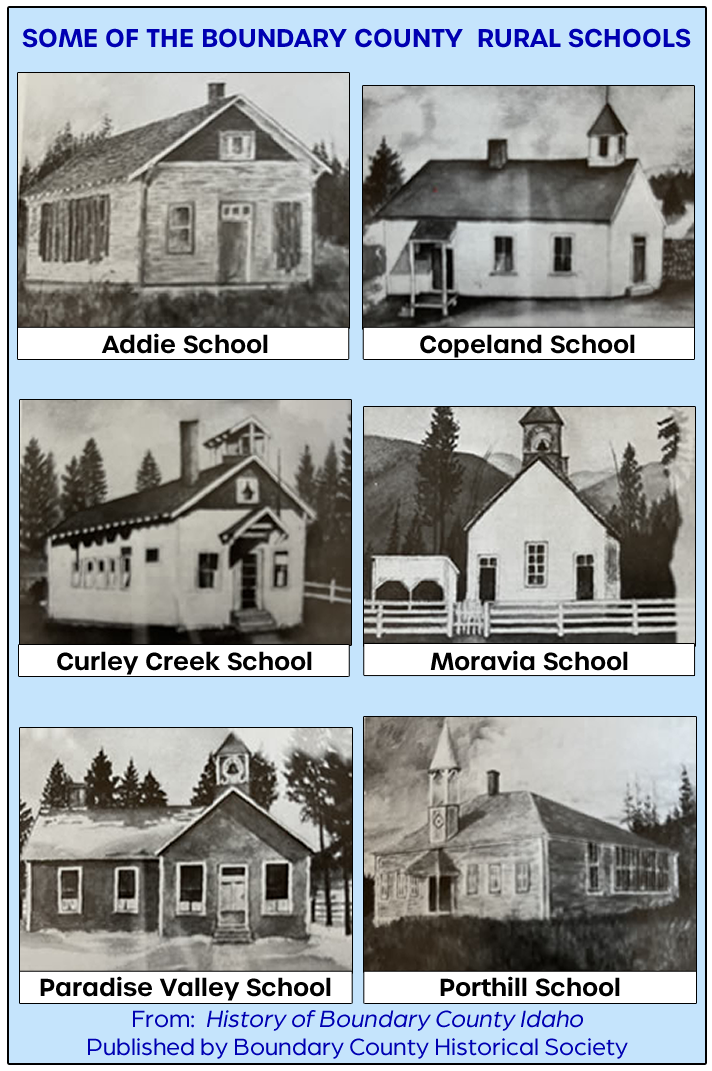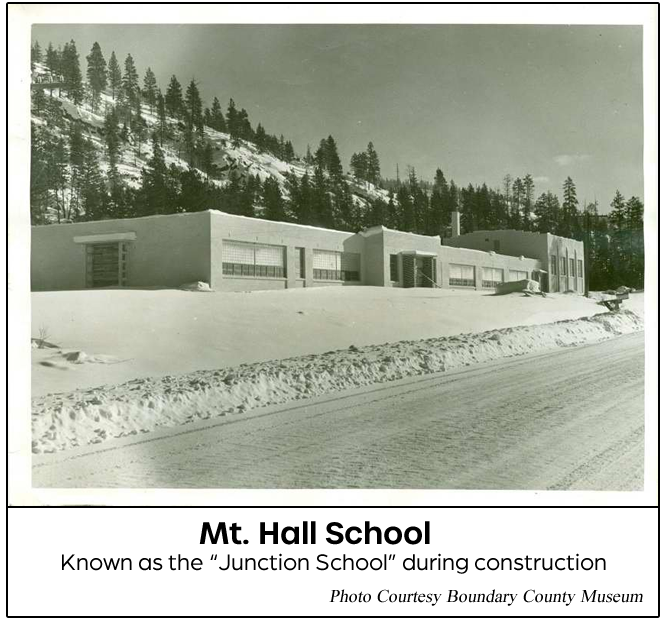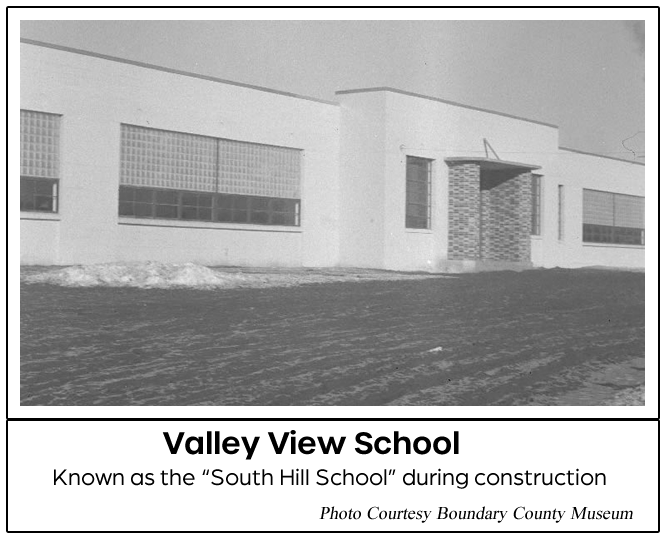 |
|
Originally published March 7, 2022,
re-published August 27, 2022 |
If you were a student
in Boundary County in the first half of the
1900s, this is what your educational landscape
looked like: Bonners Ferry had Bonners Ferry
High School, a centralized school for
high-school age students from all over the
county. Northside and Southside schools were
also in Bonners Ferry, housing students through
the first eight grades of their education.
Outside of Bonners
Ferry, in the more rural areas of the county
were the country schools. These schools were
scattered all over the county. Every community
area of the county had one. Picture in your mind
the pioneer-style “one room” country
schoolhouse, and you won’t be far off in
imagining what Boundary County’s rural community
schools looked like.
Although some of the
community rural schools sprung up and later
faded with population shifts around the county,
by midcentury these were the rural community
“one room” schools in Boundary County:
• McRae School
• Moravia School
• McArthur School
• Paradise Valley
School
• Cow Creek School
• Moyie Springs
School
• Sheridan School
• Addie School
• Eastport School
• McKinley School
• Copeland School
• Porthill School
• Meadow Creek School
• Lindberg School
• Buckhorn School
• Curley Creek School
• And the Naples
School. Although the Naples School was a rural
community school, it was a much larger
multi-room and multi-level building, serving the
Naples community.
Here are photographs
of paintings of some of these early schools,
painted by local artists S.S. “Slim” Allured and
Estella Thomas. These photographs are from the
book History of Boundary County, published by
the Boundary County Historical Society.
(Story continues below this photograph)

Each one of these
schools had their own local board of directors
and trustees, and operated independently of one
another. For that matter, even Northside and
Southside Schools in Bonners Ferry were in their
own school districts, Southside being District
#4 and Northside being District #14.
And that was the
educational system in Boundary County back then.
And all that changed,
beginning in 1947.
It all started down
in Boise. The 1947 Idaho legislature passed a
total of 30 measures dealing with education
during their legislative session that year, and
one of those measures addressed consolidating
the many school districts scattered across
Idaho’s counties into more uniform centralized
districts within the counties.
At meetings held in
Boundary County in 1947, trustees from the
schools all over the county voted to reorganize
to form a single consolidated school district
for all of Boundary County. At a special
election held in October 1947, voters endorsed
that reorganization plan by a vote of 519 to 90.
Several days later, the new Boundary County
Class “A” School District 101 was officially
formed, and trustees for the new district were
appointed.
Consolidation meant
bringing together all the scattered rural
community schools, the Bonners Ferry town
schools, and all the students and teachers of
those schools into the single new county-wide
school district. Within a short time, trustees
of the new District 101 were discussing a
sweeping new building project. The project would
phase out all of the scattered rural community
schools in favor of new, much larger schools
built to accommodate all students in the county.
Except for the high school, Boundary County had
never had such centralized schools before.
Plans were made to
construct two brand new schools for the pre-high
school age students, and locations for those new
schools were selected. The school for the
northern part of the county was a location known
as the “International Junction,” located near
Copeland at the junction of two important
roadways in the county, both leading into
Canada. The site for the second new school
building was a location on the South Hill area
of Bonners Ferry. At the same time, plans were
made to expand the Naples School with the
addition of an “annex,” also to construct a new
Ag shop at the high school.
In addition, the
building program included future plans for a
third new school in the county. The third
planned school was to be located somewhere east
of the Moyie River to provide a new,
consolidated building for students who had been
attending the Curley Creek and the Buckhorn
schools. Plans for this school were put on hold
until a later date, awaiting final decisions on
the ultimate location of U.S. Highway 2 running
from Moyie Springs into Montana, that highway
also being planned at that time. This third
building would be situated east of the Moyie
River to avoid transporting students through the
Moyie Canyon’s narrow, winding, dangerous road.
District trustees met
with architects, engineers, attorneys, and
financial firms, and once all plans and
schematics were made, it was determined that the
building program plans could be completed for
the sum of $395,000 (about $5.25 million in 2022
dollars). A school bond proposal was
drawn up for that amount, to submit for voter
approval at election.
The plan was to have
a “modern” eight-classroom elementary school at
the Junction site (which the Mt. Hall site was
called during construction, before the final
school name had been determined), also a larger
ten-room elementary school at the South Hill
site (this was the name for the Valley View site
before its official name had been determined),
and an additional classroom and facilities for a
new annex at Naples School. The
newly-constructed schools would include
gymnasiums, cafeterias, visual education rooms,
health rooms, and libraries.
All this was a
radical change from the educational system
previously operated in Boundary County and in
many rural counties throughout Idaho and
throughout the United States. The patchwork of
the rural community, neighborhood schools,
governed by local community school boards, had
been the pattern for generations, and many
adults, including parents of current students,
had themselves grown up with those rural
schools. This was a significant cultural shift
in society in Boundary County and in Idaho. The
newly organized School District 101 responded to
the needs of this sweeping change with an
ambitious program to build two completely new
large, fully-equipped modern schools, both from
scratch, both to be constructed at the same
time, also at the same time upgrading and
expanding the Naples School. Additional plans
were set for a later calendar date to construct
from scratch yet a third brand new school in the
eastern part of the county.
A date was chosen for
voting on the proposed $395,000 school bond: May
22, 1948. When that particular date arrived that
spring, voting wasn’t the only thing going on.
The waters of the county’s rivers were rising
rapidly, and caused great concern throughout the
county. In spite of the increasing worry over
the threatening waterways, voters turned out on
that day and voted in favor of the proposed
school bond by a 70% margin.
The very next day,
flood waters broke through part of the Kootenai
River dike and flooded the county’s District 7.
Within days flood waters covered all the
district farm lands and low-lying parts of the
town of Bonners Ferry along the river. This was
the famous Bonners Ferry Flood of 1948.
The school district
realized that even with the flooding, the need
for the new school buildings had not changed,
and the decision was made to proceed with the
building program. With the necessary $395,000 in
funding now available, the district three times
solicited bids for the big construction project,
and each time rejected all bids, as all came
back higher than the money the district had
available for the project.
After the third
rejection of all bids, the district trustees,
convinced they could complete the project on
their own within budget limitations, dispensed
with seeking bids, and hired their own labor
force, largely from workers right within
Boundary County. They hired local resident
Clifford Hill as general superintendent for the
construction project.
Three and a half
months after the voters had approved the bond
proposal, in early October 1948, work began with
a project to bring water from nearby Mission
Creek to the new “Junction” school site. By
early November 1948 work began on the Junction
school building itself with excavation for the
building’s footings. Within a few weeks, work on
the South Hill school site began.
District trustees and
construction supervisors were always on the
lookout to find ways to conserve money on the
project, to make sure they stretched the funds
to have enough to complete the program. One
example of this was in the use of wooden forms
built for pouring concrete. Those forms were
built at the Junction site, and used to pour
concrete there for the footings, foundation, and
the boiler room of the building. When the
concrete pouring was completed at the Junction,
those same forms were taken to the South Hill
school site in Bonners Ferry, where they were
used again to pour the same concrete components
there, thereby saving money and materials on the
project.
Money was also saved
when the district was able to acquire
war-surplus boilers and radiators from the
Farragut Naval Training Station and from the
Baxter Hospital for the heating systems used in
the new schools.
The new school year
for the fall of 1949 opened with crowded
conditions at the existing schools, but it was
estimated then that the new buildings would be
completed and ready for occupancy by the
beginning of the school-year’s second semester,
coming up in January, only four months away.
Enrollment for all schools in the district on
that first day of school in 1949 was 1,323
students, which was 23 more than had been
present on the first day of school the previous
year.
By mid-October 1949
it was announced that the South Hill school was
80% complete. The exterior painting at the South
Hill site, with a few minor exceptions, was
essentially done. All steam work had been
roughed in. Rooms within the building were being
lathed and prepared for plastering.
At the Junction
school site, difficult winter weather had slowed
the project to a near standstill, yet still the
construction of that building was 75% complete.
A story in the
Bonners Ferry Herald discussing the ongoing
school construction described the buildings:
“Both of the new buildings are of pumice block
construction, brick adding a decorative effect
to entrances. The exterior painting is light
green in color.”
Toward the end of
December, the South Hill site, though still not
complete, had progressed to the point where just
before Christmas break, about 100 students from
grades 6, 7, and 8 were moved into the new
building from the town Southside School. Plans
were for the new South Hill school to eventually
enroll a total of 350 students in grades 4 – 8,
with the remaining students coming to the school
later from the Sheridan, Moyie Springs, Cow
Creek, and Paradise Valley rural community
schools, and also from Bonners Ferry’s Southside
and Northside schools.
As 1949 came to a
close, it became apparent that some features of
the new schools would not be fully completed on
time as planned, due to funds in the district’s
construction accounts starting to run low. For
example, it was anticipated that the schools’
cafeterias would be completed, but the kitchen
equipment would not be ready as planned. Also,
it was felt the gymnasiums would not be
fully completed, but would still be usable. It
was decided to proceed with moving students into
the new schools at the appointed times. District
trustees felt the schools, though not 100%
complete, would still be usable, and that the
school consolidation program would continue to
proceed.
Official opening
dates for the schools were set: The newly-named
Mt. Hall school at the Junction site would open
for instruction on Monday, January 23, 1950. The
new South Hill school, although the 100 students
had already been moved previously into the
school, would officially open with its full
complement of students one week later, on Monday
January 30, 1950.
The school district
put out an appeal to the public for help in
moving furniture and equipment from the older
rural schools and from the town schools into the
newly constructed Mt. Hall and South Hill
schools (apparently Valley View school’s name had not
yet been discovered). Dozens of people
volunteered with trucks to help in transporting
the equipment, and many others gathered to help
load and unload everything. Although the date
for moving the equipment twice had to be
postponed due to winter weather, the task was
finally accomplished. During those moves, coffee
and doughnuts were provided to the busy movers
by the Kiwanis Club, along with help from Ms.
Peters' Bonners Ferry High School home economics
class students.
On the announced
days, with furniture and equipment moved into
the schools, final details of construction being
wrapped up, and in spite of record January
snowfalls that year, the two new schools
officially opened. New students, transferring
from multiple rural schools from all around
Boundary County, flowed through the doors and
into the classrooms of the two new buildings.
(Story continues below these two
photographs)


As those students
entered the new buildings, they were welcomed by
new principals Ted Moline at Mt. Hall School,
and N.B. Martin at the South Hill school, along
with their full teams of teachers and faculty.
And also, as those
students entered the new buildings that day,
nine rural community schools closed for the
final time: Paradise Valley School, Cow Creek
School, Moyie Springs School, Sheridan School,
Addie School, Eastport School, McKinley School,
Copeland School, and Porthill School, joining
three schools that had already closed
previously: McRae School, Moravia School, and
McArthur School.
Four rural schools
remained in operation, presumably awaiting the
construction of the planned third new school
building east of the Moyie canyon: Meadow Creek
School, Lindberg School, Buckhorn School, and
the Curley Creek School.
Boundary County
became the first county in Idaho to complete
county-wide school district consolidation under
the laws enacted during the 1947 Idaho
legislative session.
With students from
all over the county now moving into the new
consolidated schools, the district needed to get
those students from locations all over the
county transported to those new schools. This
large endeavor also involved much time,
planning, and expense. The district employed 20
school buses, along with two private
automobiles, in the operation of moving students
from their homes to their schools, and back
again. It was estimated at the time that the
buses traveled a combined 730 miles each school
day to accomplish their task.
Life moved on. On
February 10, 1950, only a couple of weeks after
Mt. Hall School opened, the Mt. Hall PTA had
their meeting at the new school. A potluck
dinner was served to all, and after dinner the
PTA began making plans to raise funds to help
complete the final details on the building
cafeteria and the kitchen. A committee was
organized to build benches for the cafeteria
tables.
Those generations
ago, the Boundary County community set forth on
an ambitious large-scale project to effect a
major, unprecedented change in the organization
and management of Boundary County schools, in
the process building from scratch—and at the
same time—two completely new full-scale school
buildings and upgrading the Naples School
building. Most of the work was done by local
Boundary County workers, who got the project
done on time and within budget.
Ultimately the third
new school building that had been planned for
later east of the Moyie canyon was also
constructed and put into service—that was the
Evergreen School.
With this ambitious
program for school consolidation and new
construction, significant changes in the
cultural fabric of our Boundary County community
also evolved, as the small rural community
schools fulfilled and completed the mission of
their time, and were ultimately closed.
Those citizens of
1950 Boundary County may little have dreamed
that the schools they built for their own
Boundary County children, and for Boundary
County children of the future, would still be in
full operation 72 years later in the year 2022.
The Board of Trustees
of today’s Boundary County School District 101,
after a full two-year detailed assessment of
those same buildings and all other buildings of
the district, has determined that the time has
come to rebuild the 1950 South Hill
school—Valley View School. The election for
Boundary County voters to respond to that
proposal is set for this coming Tuesday, Tuesday,
August 30,
2022.
Please plan on taking
a moment from your day on Tuesday to stop by your
polling location and cast your vote in this
important election that will likely shape a big
part of the future of our local schools for more
decades to come.
|
|
|
|
|
|
|

